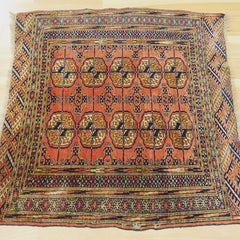Tribal Rugs
What is a Tribal Rug?
Tribal rugs in our collection generally describe hand knotted Oriental rugs woven by nomadic and semi-nomadic peoples. In contrast to city rugs woven in workshops in more densely populated areas, these tribal carpets are less structured and often times have more imperfections. Known for their unique designs and colors, tribal Persian rugs provide plenty of character for a space and can spark a conversation. They are more difficult to duplicate and for that reason they are truly one of a kind rugs.

Weaving Tribal Rugs
Nomads use horizontal looms which allows them to break the loom down when traveling. These looms, although handy to break down, restrict the width of the rug being woven. Most tribal rugs tend to be smaller than the typical room-size Persian carpet for that reason, although runners are still common in tribal styles.
Tribal Rug Designs
There is a wide range of designs found in tribal rugs, many use bold geometric patterns, rectilinear animal motifs and specific medallions depending on the origin. Earth tones and other colors reflecting the weavers surroundings are common. Weaving, dyeing and patterns are generally passed down from generation to generation. Each handwoven tribal rug has a story to tell, and this is why they are such special and unique pieces. Identifying tribal rugs can be difficult, but generally the structure of the weave, colors used, and specific designs will tell you where the rug came from. Unlike city rugs, tribal rugs rarely have cotton foundations and are usually made with wool piles and wool foundations although camel and/or goats hair may be used as well.
Types of Tribal Rugs
 Several types of tribal rugs include the Qashqai, Afshar, Khamseh, Kurdish, Hamedan, Bidjar, Bakhtiari, Baluch, Turkish, Caucasian, Turkmen, and Afghan rugs. Although not all Turkish and Caucasian rugs are woven by nomads, some can be characterized by tribal motifs and styles.
Several types of tribal rugs include the Qashqai, Afshar, Khamseh, Kurdish, Hamedan, Bidjar, Bakhtiari, Baluch, Turkish, Caucasian, Turkmen, and Afghan rugs. Although not all Turkish and Caucasian rugs are woven by nomads, some can be characterized by tribal motifs and styles.




















